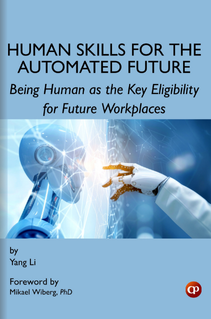Understanding AI in the Workplace

by Yang Li
Academic Researcher & K-12 Consultant, Jiangsu-Nanjing 210023, China.
10.46679/9788196780586ch01
This chapter is a part of: Human Skills for the Automated Future: Being Human as the Key Eligibility for Future Workplaces by Yang Li
ISBN (Ebook):978-81-967805-8-6
ISBN (Softcover Print):978-93-49926-23-3
© CSMFL Publications & its authors.
Published: May 15, 2025
Abstract
In the evolving modern work environments, artificial intelligence emerges as a transformative force. Despite this emergence, human capabilities still remain irreplaceable, creating an important conjuncture partnership between technological innovation and human expertise. AI technologies are enough efficient in processing big amounts of data, executing repetitive tasks with high accuracy and speed. These systems can analyze complex datasets, generate quick insights, and automate routine tasks that traditionally required significant human working hours. With its ability to handle computational and analytical tasks efficiently, AI allows human professionals to redirect their energy toward more strategic, creative, and emotionally intelligent responsibilities.
The collaborative potential between AI and human workers represents a symbiotic relationship. In an AI-powered workplace, AI handles data-driven and algorithmic tasks while humans bring critical skills such as empathy, critical thinking, complex problem-solving, and innovative reasoning. Emotional intelligence, free communication, and adaptive decision-making remain distinctly human competencies where AI systems cannot fully replicate human judgment. Organizations can use AI as a force multiplier tool, increasing workforce productivity and helping employees to focus on high-value tasks. Machine learning algorithms can further support decision-making processes by providing predictive analytics, identifying patterns, and offering objective recommendations. Despite all these things, human oversight remains in key role in interpreting these insights, understanding contextual meanings, and making final strategic decisions.
The future workplace will not be about AI replacing humans, but creating an integrated ecosystem where technological capabilities complement human skills. Professionals who develop proficiency in working alongside AI systems, understanding their strengths and limitations, will be valuable resources for an organization. The chapter explores and analyzes the fundamentals of artificial intelligence (AI) and its applications in professional work environments. Machine Learning has emerged as an important component of AI, wherein algorithms improvise and evolve autonomously, sometimes independent of explicit programming instructions.
This chapter addresses contemporary misconceptions regarding AI’s impact on human employment. Rather than entirely replacing human workers, AI reconfigures activities and functions, generating opportunities for the development of novel competencies. Human workers and AI systems form efficacious partnerships, integrating human innovation, analytical capabilities, and interpersonal understanding with AI’s capabilities in data processing and task automation.I in fact augments human work performance in very quantifiable ways. The technology adds efficiency, increases productivity, and reinforces decision-making abilities through instantaneous data analysis. When individuals collaborate with AI systems, they can engage in more complex job responsibilities that showcase their specific expertise. Professionals who understand AI and its applications will acquire the requisite skills to excel in the future workplaces.
Keywords: Artificial Intelligence (AI), Machine Learning, Automation, Workplace Transformation, Job Roles, Human-AI Collaboration
References
- Badhurunnisa, M., & Dass, S. (2023). Challenges and Opportunities Involved in Implementing AI in Workplace. International Journal for Multidisciplinary Research, 5(6). https://doi.org/10.36948/ijfmr.2023.v05i06.10001
- Bankins, S., Ocampo, A. C., Marrone, M., Lloyd, S., & Woo, S. E. (2023). A multilevel review of artificial intelligence in organizations: Implications for organizational behavior research and practice. Journal of Organizational Behavior, 45(2). https://doi.org/10.1002/job.2735
- Benbya, H., Davenport, T.H., & Pachidi, S. (2020). Special Issue Editorial: Artificial Intelligence in Organizations: Current State and Future Opportunities. MIS Quarterly Executive, 19, 12.
- Howard, J. (2019). Artificial intelligence: Implications for the Future of Work. American Journal of Industrial Medicine, 62(11), 917–926. https://doi.org/10.1002/ajim.23037
- Jarrahi, M. H. (2018). Artificial Intelligence and the Future of work: Human-AI Symbiosis in Organizational Decision Making. Business Horizons, 61(4), 577–586. https://doi.org/10.1016/j.bushor.2018.03.007
- Kapoor, R., & Ghosal, I. (2022). Will Artificial Intelligence Compliment or Supplement Human Workforce in Organizations? A Shift to a Collaborative Human – Machine Environment. International Journal on Recent Trends in Business and Tourism, 06(04), 19–28. https://doi.org/10.31674/ijrtbt.2022.v06i04.002
- Minghai, Y., Wenqing, L., Khan, W. A., Kasture, A., & Riasat, S. (2023). Supercharge Your Productivity with Artificial Intelligent. 2(02), 72–81. https://doi.org/10.56741/bst.v2i02.359
- Morandini, S., Fraboni, F., De Angelis, M., Puzzo, G., Giusino, D., & Pietrantoni, L. (2023). The Impact of Artificial Intelligence on Workers’ Skills: Upskilling and Reskilling in Organisations. Informing Science: The International Journal of an Emerging Transdiscipline, 26(1), 39–68. https://doi.org/10.28945/5078
- Poba-Nzaou, P., Galani, M., Uwizeyemungu, S., & Ceric, A. (2021). The impacts of artificial intelligence (AI) on jobs: an industry perspective. Strategic HR Review, 20(2), 60–65. https://doi.org/10.1108/shr-01-2021-0003
- Siradhana, N. K., & Gandhi, R. (2023). The AI renaissance in HR: Exploring modern solutions. International Journal of Research in Human Resource Management, 5(2), 149–152. https://doi.org/10.33545/26633213.2023.v5.i2b.163
- Tasheva, Z., & Karpovich, V. (2024). Supercharge Human Potential through AI to Increase Productivity the Workforce in the Companies. American Journal of Applied Science and Technology, 4(02), 24–29. https://doi.org/10.37547/ajast/Volume04Issue02-05
This book is available worldwide via EBSCOhost Academic Collection, EBSCO E- books, Google Play Books, Amazon, World Cat Discovery Service/OCLC, CSMFL Bookstore, and 200+ book resellers and academic content vendors.
Statement on Publication Ethics
We, at CSMFL Publications, are committed to ensure the unbiased and transparent publishing, and upholding the high standards of editorial integrity in our publications. To know more, please read our Statement on Publication Ethics, Editorial Integrity & Misconduct